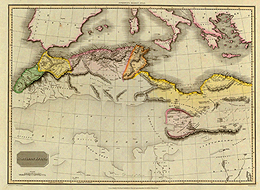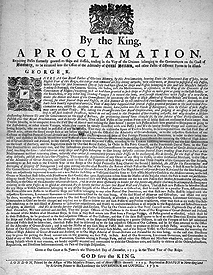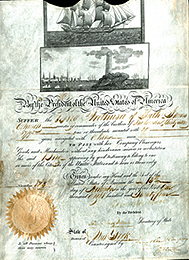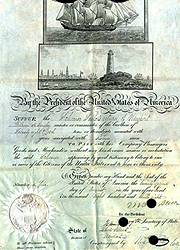|  |   |  Passports Provided Protection from Pirates
(11/30/2009) It is a tale ripped from today’s headlines: pirates off the coast of Africa board vessels and seize hostages and cargo. They demand exorbitant ransoms, and when paid let their captives go. It is a sometimes deadly, often lucrative business, netting successful marauders multi-million dollar payoffs for each ship and crew. Where U.S. Customs and Border Protection is concerned, this is also a story that is centuries old. It is a tale ripped from today’s headlines: pirates off the coast of Africa board vessels and seize hostages and cargo. They demand exorbitant ransoms, and when paid let their captives go. It is a sometimes deadly, often lucrative business, netting successful marauders multi-million dollar payoffs for each ship and crew. Where U.S. Customs and Border Protection is concerned, this is also a story that is centuries old. |  | click for hi-res
 | | This 1814 map by John Pinkerton shows the northern coast of Africa. The Barbary nations depicted are Morocco (here as Morocco and Fez), Algiers, Tunis, and Tripoli (now Libya). |
| |
Photo Credit: David Rumsey Map Collection, www.davidrumsey.com |
|
|  |  |
The Barbary Coast - the North African, southern Mediterranean region including Morocco, Algiers, Tunis, and Tripoli (now known as Algeria,  |  | click for hi-res
 | | A proclamation issued by King George, reprinted in Boston in 1730, required ships and vessels trading along the Barbary coast to return their passes granting trading privileges to “Officers of Our Customs” and be issued new ones. |
| |
Photo Credit: Library of Congress, Rare Book and Special Collections Division |
|
|  |  |
Tunisia, and Libya) - was a particularly treacherous zone through the mid nineteenth century. Capture by Barbary pirates often meant torture, enslavement, and the confiscation of goods and ships. Some governments negotiated treaties and paid monetary tributes to the Barbary rulers to secure safe passage for their subjects. Colonial American vessels in the Mediterranean traveled under the protection of the British crown and were issued passes granting trading privileges. During the Revolutionary War, American ships were safeguarded through our alliance with France. After Independence, though, American traders were in competition with merchants of other nations, whose navies looked the other way. The fledgling American government had no forces to defend her countrymen from pirate attacks. As a consequence, our ships were seized, and high fees were paid to secure their release and the return of their surviving crews.Morocco signed treaties with the United States and did not attack our vessels. Text of a 1786 agreement included the following clause: “The Commerce with the United States shall be on the same footing as is the Commerce with Spain or as that with the most favored Nation for the time being and their Citizens shall be respected and esteemed and have full Liberty to pass and repass our Country and Sea Ports whenever they please without interruption.” | click for hi-res
 | | Mediterranean passport issued November 13, 1824 to the Arethusa of Bath. |
| |
Photo Credit: U.S. Customs and Border Protection historical collections |
|
|  |  |
The treaty signed at Tripoli in 1796 stated: “Proper passports are to be given to all vessels of both parties, by which they are to be known. And considering the distance between the two countries, eighteen months from the date of this treaty shall be allowed for procuring such passports.” Over the next several years, other treaties with the Barbary nations also covered issuance of passports and payment of duties for trade goods. A ship’s passport did not exempt her crew from carrying individual proof of citizenship.There was no expectation that pirates in the Mediterranean would speak - or read - English. Passports were designed with a curved, scallop-shaped cut-out top edge, engraved illustrations and an official seal, and were printed on vellum (parchment made of treated animal skin, used instead of fiber-based paper). To authenticate documents, Barbary Coast officials were sent examples for comparison, including the matching curved piece from the top edge. Holes punched through the official signatures indicated a cancelled document.CBP holds two such Mediterranean passports in our historical collections. The  |  | click for hi-res
 | | Mediterranean passport issued August 22, 1838 to the schooner Sailor’s Return. A note on the reverse states that the passport was surrendered at the port of Newport on December 29, 1838, because the vessel was “lost on Cape at Rogue Shoals.” |
| |
Photo Credit: U.S. Customs and Border Protection historical collections |
|
|  |  |
earliest is dated 1824, issued for the brig “Arethusa of Bath.” It is signed by President James Monroe, Secretary of State John Quincy Adams, and Collector of Customs for the District of New York Jonathan Thompson. The second passport was issued to “Sailor’s Return,” a schooner, in 1838. It is signed by President Martin Van Buren, Secretary of State John Forsyth, and William Littlefield, the Collector of Customs for the District of Newport, Rhode Island.In 1801, the Bey of Tripoli declared war on the United States when we refused to pay more in tribute. President Thomas Jefferson ordered a naval squadron to the Mediterranean to win the first Barbary War. Over the next several years, Congress continued supporting its Mediterranean forces by repeatedly renewing “An act further to protect the commerce and seamen of the United States, against the Barbary powers.”The pirates continued their marauding ways, even after a victory by the U.S. in a second Barbary War in 1815 against the Dey of Algiers - though no more American ships were captured. It was not until after France’s conquest of Algeria in 1830 that Barbary piracy finally came to an end. Congress eliminated the fee for obtaining a Mediterranean passport in 1831, and they remained in limited use for another thirty years. |
 |
|  |  |  |
|